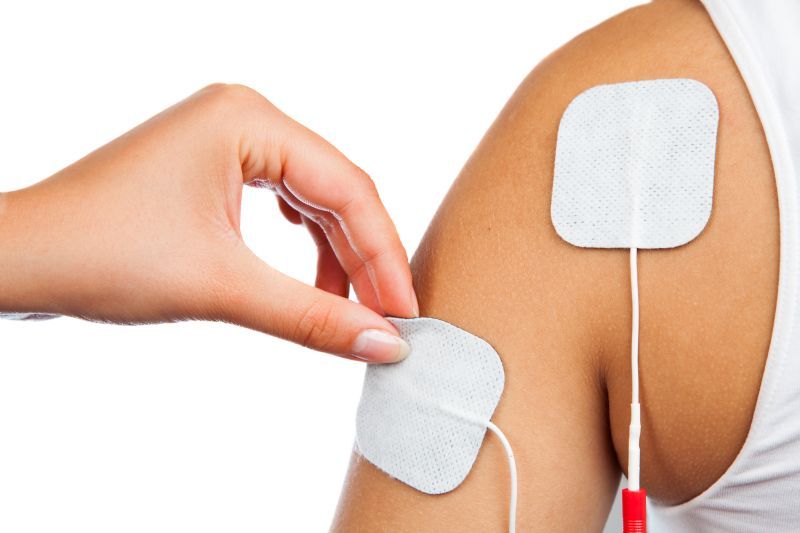 Written by Dr. Eric Wood, ND, MA
Written by Dr. Eric Wood, ND, MA
Electrotherapy is a therapeutic medical treatment employing electrical impulses to provide various potential health benefits that aid recovery and overall health. Electrotherapy devices have numerous advantages, including pain management, muscle rehabilitation, osteoarthritis treatment, and wound healing.
Additionally, electrotherapy shows positive results in treating depression and anxiety. With more than 19% of adults in the United States suffering from anxiety disorders and more than 21 million Americans suffering from major depression, electrotherapy may be an excellent treatment option.
Electrotherapy treatments can be performed as an outpatient or purchased for home use. Electrotherapy utilization has increased in recent years as more research into its efficacy has been conducted with promising results.
Electrotherapy is a type of physical therapy modality that involves the application of low-voltage electricity to the body to achieve various outcomes, including pain relief and muscle rehabilitation. It sends tiny electrical impulses to the treated area via electrodes, with each impulse activating different nerve fibers and stimulating muscles throughout the body. Electrotherapy's effects can vary depending on the mode, frequency, intensity, and type of current used.
Because of its ability to reduce inflammation and promote healing at the cellular level, electrotherapy effectively reduces stress levels while also assisting in managing pain. Due to the numerous therapeutic benefits of electrotherapy, physical therapists and rehabilitation practitioners offer it as an effective treatment modality in their practices.
One of the most significant advantages of electrotherapy is that it is non-invasive. This means the procedure carries no risks, such as infection or scarring. Furthermore, the treatments are simple to administer and usually take less than 30 minutes per treatment.
There are a few different mechanisms of electrotherapy that can promote natural healing. Electrical stimulation causes muscles to contract and relax, pumping more blood through vessels. This increased blood flow delivers oxygen and nutrients to the cells and tissues, promoting healing.
In addition, there is no risk of addiction because electrotherapy helps the body recover without additional pain medications.
One of the primary applications of electrotherapy is pain relief due to its effects on reducing muscle tension and spasms while aiding in chronic pain management. Nerve fibers are stimulated by electrical impulses delivered through the electrodes placed on or near the painful area, blocking pain signals.
Furthermore, electrotherapy can increase blood flow to an injured area, which aids healing by increasing the amount of oxygen and nutrients available for tissue repair.
Electrotherapy stimulates endorphins, which act as natural painkillers in the body, providing a longer-lasting effect than traditional pain medications alone.
As a result, many people benefit from regular electrotherapy treatments for musculoskeletal pains.
Electrotherapy revolutionized physical and mental health treatments thanks to its essential role in endorphin release. Endorphins are happy hormones that interact with the brain and nervous system receptors to produce feelings of pleasure or euphoria.
When electrotherapy is used to treat physical ailments, electrical impulses are sent through electrodes placed near nerve endings on the skin. These impulses stimulate peripheral nerves and trigger endorphin release in our bodies; they can also reduce inflammation and promote natural healing at the cellular level.
Certain types of electrotherapy, such as the TENS units, have been shown to increase the production of serotonin, another neurotransmitter that plays a vital role in mood and stress regulation. Thus, electrotherapy is an effective way to increase endorphin levels and reduce pain in patients suffering from chronic illnesses or injuries because it provides psychological and physiological benefits.
Electrotherapy stimulates the muscles, causing the muscles to contract and the blood to circulate throughout the body. Increased blood flow improves circulation, especially in areas with blockages or restrictions. Electrotherapy is helpful in wound healing as congestion and inflammation are reduced.
When performed correctly, electrotherapy is generally regarded as safe. It provides many potential benefits without the significant side effects or risks associated with medications or surgery, making it an appealing option for those seeking symptom relief. When using an at-home device, the primary risk is failing to follow the manufacturer's instructions and holding the device in one place for too long, causing discomfort.
With the rising cost of healthcare, many of us are looking for cost-effective alternatives to achieve therapeutic objectives. Electrotherapy can be used in the comfort of your home, with various low-cost products available. Furthermore, clinic electrotherapy treatment is inexpensive compared to other alternative therapies.

Electrotherapy can help with chronic pain in a variety of ways. Electrotherapy, for example, can reduce inflammation and swelling, increase blood flow, and release endorphins, all of which reduce chronic pain's impact on the body.
Many research studies and ongoing trials prove that electrotherapy successfully reduces pain by blocking pain transmission to the central nervous system.
According to the American Migraine Foundation, neuromodulation devices use electrical current or magnetic energy to reduce overactive brain activity. These devices are effective for treating migraines that are currently occurring and are a great preventative treatment option as well.
There are FDA-approved devices available, including transcranial magnetic stimulation (TMS), a non-invasive technique that uses magnetic fields to stimulate nerve cells in the brain. Initially approved for acute migraine treatment, it is also approved for preventative therapy.
Additionally, the transcutaneous vagus nerve stimulator is another effective electrotherapy for migraines. The electrical activity targets the vagus nerve and is proven effective for acute migraine pain. The FDA approved this electrotherapy in 2021 for use in ages 12-17.
Cranial electrotherapy stimulation (CES) is a novel treatment for the symptoms of depression and anxiety. CES uses mild electrical stimulation to activate the brain and stimulate endorphins. The good news is that this therapy can be done at home and does not require any medication or invasive treatment. It is FDA-approved but requires a prescription for use.
CES causes stimulation in the brain near the hypothalamus. It works by bringing the neurochemicals back into balance. It is a safe and effective treatment that most patients benefit from after only a few consistent sessions. Additionally, it can be used as needed for episodes of increased anxiety or depression.
Muscle atrophy is a condition where muscles waste away due to lack of use. This can happen after an injury or illness and can also occur in older adults who are not physically active. Muscle atrophy can lead to weakness and mobility problems.
Electrical myostimulation (EMS) can help to reverse muscle atrophy by providing the muscles with the stimulation they need to contract and function properly. This therapy can also help to prevent muscle atrophy from occurring in the first place.
EMS is frequently used to rebuild muscle mass in otherwise healthy patients who have been injured and those with muscle atrophy who cannot perform strengthening exercises.
Electrotherapy is an effective tool for wound healing due to its ability to reduce inflammation and promote cellular regeneration. Electrical stimulation delivered through electrodes placed on or near the wound helps stimulate nerve fibers which can block pain signals sent from the area while also increasing blood flow in the affected region. This increased circulation helps deliver more oxygen and nutrients needed for tissue repair, resulting in faster healing times.
Ultimately, electrotherapy provides those suffering from injury-related wounds with a safe and effective way of managing their symptoms while allowing them to return to their regular activities quicker than other treatments available today.
Furthermore, electrotherapy is helpful in reducing scarring caused by wounds as it helps increase collagen production within tissues, promoting skin elasticity and leading to less visible scars over time.
Osteoarthritis is a condition that is characterized by pain, swelling, and stiffness in the joints. Electrotherapy relieves osteoarthritis symptoms by stimulating nerve fibers that block pain signals sent from the area.
Furthermore, electrical stimulation increases blood flow to an affected area, which reduces inflammation and swelling while promoting faster healing times and more extended pain relief.
Tendonitis and bursitis are both common causes of joint pain and inflammation. Electrotherapy aids healing by increasing blood flow and oxygen to the affected joint, reducing pain and inflammation, and ultimately improving joint mobility.

Electrotherapy can significantly reduce pain and improve mobility in people suffering from both acute and chronic medical conditions. It is non-invasive and safe, making it an ideal treatment option without using medications or surgery.
Many electrotherapy options are available for home use with the same technology utilized by physical therapy, clinics, and other healthcare institutions.
To learn more about this innovative therapy, please check out the electrotherapy devices we offer from high-quality manufacturers.
For other informative articles, check out our Caregiver University blog.

Dr. Wood is a licensed naturopathic doctor in Washington D.C. and founder of Visionary Health. A graduate of the Canadian College of Naturopathic Medicine, Dr. Wood is a professor at John Patrick University in the Integrative and Functional Medicine Department as well as an adjunct professor at the American College of Healthcare Sciences in Holistic Nutrition. He began his career as a specialty physician for two leading supplement US companies, Neuroscience Inc. and Life Extension. Over his fifteen-year career in integrative and holistic medicine, he has worked in diverse capacities including as an educator; writer; medical advisor, consultant and formulator for supplement companies and treatment centers in the US and the EU; public speaker; and clinician. He has long been a practicing advocate of lifestyle medicine, fitness and mind body medicine approaches initially spurred by aging family members not getting help from traditional medicine and is passionate about innovating and bringing natural and integrative medicine to the masses!